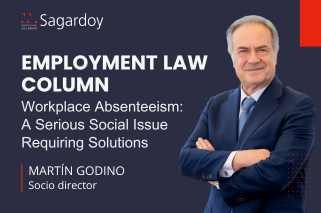Law 2/2025 and the Termination of Employment Contracts Due to Permanent Disability: From Automatic Termination to Reasonable Accommodation and Worker Redeployment
The enactment of Law 2/2025 of 29 April represents a milestone in the development of Spanish labour law, as it structurally addresses the termination of employment contracts on grounds of permanent disability. Through the amendment of Article 49 of the Workers’ Statute (Estatuto de los Trabajadores, “ET”), the reform moves away from the previously existing automatic termination model and replaces it with a framework based on the principles of reasonable accommodation and the redeployment of the affected worker.
The ultimate aim of this reform is clear: to align the legal regime governing permanent disability with that applicable to disability, in accordance with Law 3/2023 of 28 February on Employment. The latter amends, in its second final provision, certain articles of the General Law on the Rights of Persons with Disabilities and their Social Inclusion, enacted by Royal Legislative Decree 1/2013, by establishing the automatic recognition of disability status for individuals awarded a permanent partial disability (IPP). This legislative alignment, as stated in the preamble of Law 2/2025, is also required under European Union law—particularly Directive 2000/78/EC—and the United Nations Convention on the Rights of Persons with Disabilities.
All of this is without prejudice to the fulfilment of the protective scope of the principle of equality and non-discrimination under Articles 4.1 and 6.1(a) of Law 15/2022—provisions that, surprisingly, are not expressly referenced in the preamble of Law 2/2025.
The key aspect of the new Article 49.1(n) of the Workers’ Statute is that the employment contract may only be terminated following a declaration of major disability, absolute permanent disability, or total permanent disability if specific conditions are met. Chief among these is that the worker, within ten calendar days from the communication of the disability resolution, does not provide written notice to the employer of their intention to continue the employment relationship.
If such written notice is submitted within the aforementioned legal timeframe, the employment relationship may only be terminated in the following cases: where it is not possible to implement reasonable accommodations as defined by the law; where no vacant position compatible with the worker’s functional profile exists; or where the worker rejects the proposed position. These circumstances would justify termination under Article 49.1(n) ET.
The transition from an automatic termination model to one focused on employment preservation undoubtedly introduces a new culture of continuity, requiring employers to adopt a proactive approach in exploring all possible avenues for reasonable accommodation and/or reassignment to a suitable vacant position aligned with the worker’s professional profile before opting for termination.
To this end, the involvement of occupational risk prevention services, in accordance with applicable regulations and following consultation with employee representatives on occupational health and safety matters, becomes central. These services must determine the scope and nature of the adjustment measures—particularly in relation to training, information, and health surveillance—and identify positions compatible with the worker’s new condition.
However, this legislative transformation is not without its tensions. The first arises from the structural ambiguity of the concept of “reasonable accommodation.” Although Law 2/2025 introduces guiding criteria—such as the size and economic situation of the company, the availability of public subsidies, and financial thresholds for SMEs—significant margins of discretion remain, potentially leading to increased litigation.
Secondly, the legal definition of a “suitable vacancy” raises important questions. Issues such as functional mobility, relocation within the same geographic area, transfers to a different worksite without changing residence, geographical mobility, and substantial modifications to working conditions arising from redeployment, as well as the interplay with preferential rights established in labour legislation, require a systematic interpretation to avoid normative conflicts, contradictory interpretations, and to ensure compliance with the principle of proportionality.
From another perspective, controversy also surrounds the mechanism for suspending permanent disability pensions when the worker continues in an adapted position. According to the new Article 174.5 of the General Social Security Law (LGSS)—amended to reflect the Workers’ Statute reform—pension suspension will apply when the new position is deemed incompatible with the pension under Article 198 LGSS. This provision may act as a disincentive to accepting adjustments if the loss of pension benefits is not offset by sufficient guarantees of stability and suitability in the new role.
Of particular relevance in this context is domestic case law and judicial doctrine on the concept of “habitual profession” in cases of total permanent disability, as well as recent European jurisprudence—especially the CJEU judgment of 18 January 2024 (Case C-631/22, Ca Na Negreta)—and, more notably, the preliminary ruling request filed by the High Court of Justice of the Balearic Islands (TSJ Baleares) on 10 March. The referral questions whether Spanish case law complies with EU Directive 2000/78/EC on equal treatment in employment and occupation as it relates to persons with disabilities, particularly in cases where the total permanent disability pension is considered incompatible with employment—even when the employee has been reassigned to a different role with functions distinct from those that gave rise to the disability.
In conclusion, although Law 2/2025 represents a significant step toward a more inclusive model, its effective implementation will depend on the terms set out in a likely and much-anticipated regulatory development. As things currently stand, the legal uncertainty generated by the new statutory wording is considerable—both for employers and for workers, especially in terms of the compatibility between disability benefits and continued employment.
We are, in all likelihood, still in an early implementation phase, and it remains to be seen whether the aforementioned regulatory development will materialise—and, crucially, how the judiciary will interpret and enforce compliance with this legal obligation.



